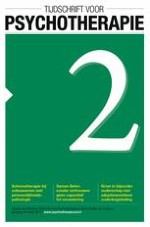24-02-2017 | Artikel
Samen Beter: in de afwezigheid van vertrouwen is er geen capaciteit tot verandering
Gepubliceerd in: Tijdschrift voor Psychotherapie | Uitgave 2/2017
Log in om toegang te krijgenSamenvatting
Evolutionair bezien is een persoonlijkheidsstoornis geen stoornis, maar een adaptatie aan een onveilig vroegkinderlijk milieu. In een onveilig milieu is de kans op overleven groter als men waakzaam is en anderen niet te gemakkelijk vertrouwt. Dit wantrouwen is dus eigenlijk een kracht en geen zwakte en daarom ook heel moeilijk te veranderen. De expliciete inspanning van de therapeut om de wereld te zien vanuit het standpunt van een patiënt is een belangrijke manier om het vertrouwen te herstellen. Een warme, authentieke en empathische houding is daarvoor van groot belang. Deze biedt uiteindelijk mogelijkheden om het vertrouwen in de sociale wereld als leeromgeving (epistemisch vertrouwen) te herstellen en erodeert het wantrouwen. Het is dus niet wát patiënten leren dat het meeste betekenis heeft, maar hóe zij het leren: het potentieel van de therapeutische relatie om de capaciteit om te leren van sociale situaties weer tot leven te wekken. De verandering wordt vervolgens vooral bewerkstelligd door wat daarna buiten de therapie weer geleerd kan worden, in de eigen sociale omgeving van de patiënt. De therapie zal dus meer succesvol zijn naarmate de omgeving van de patiënt meer goedaardig is en interventies zoveel mogelijk plaatsvinden in de context van positief betrokken familie en naasten. Door het concreet zichtbare karakter van sociaalpsychiatrische interventies bieden zij een unieke kans om de (goede) intenties van de therapeut te illustreren en daarmee het (epistemisch) vertrouwen te doen groeien. Een werkwijze volgens F‑ACT PS voegt op deze wijze iets tastbaars en waardevols toe, wat psychotherapie alleen niet kan bieden.
